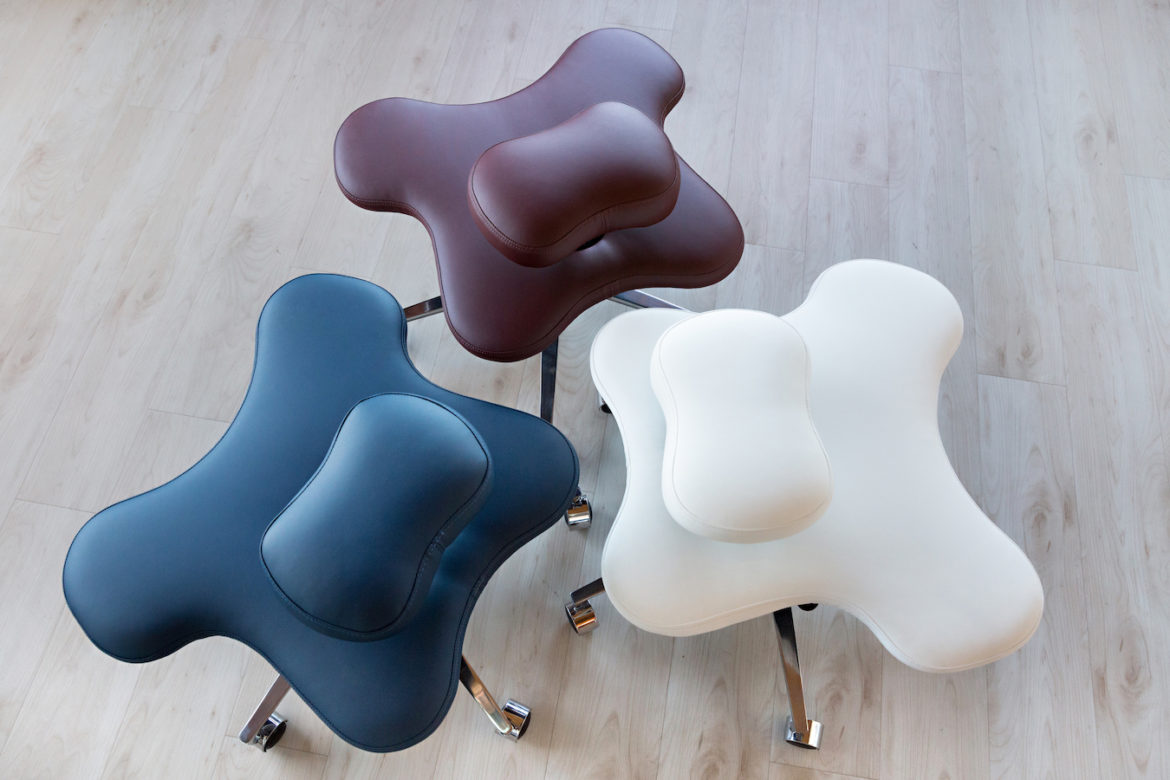Here’s some great advice about active working as we work from home in these challenging times. Galen Cranz (one of the experts quoted in the article) was an early beta tester of one of my favorite seats and what a great discovery!
 You know how it goes: One day you’re typing away at your company desk, and the next day you’re working from home indefinitely in a pandemic, hunched over your kitchen table like a potato.
You know how it goes: One day you’re typing away at your company desk, and the next day you’re working from home indefinitely in a pandemic, hunched over your kitchen table like a potato.
Cue the stabbing back pain and weird neck spasms.
 As your body has probably informed you this week, the same desk habits that suited you at the office will not work at home, where you move much less. We spoke to experts nationwide on how to arrange yourself to be comfortable and productive from your couch or bed or balcony.
As your body has probably informed you this week, the same desk habits that suited you at the office will not work at home, where you move much less. We spoke to experts nationwide on how to arrange yourself to be comfortable and productive from your couch or bed or balcony.

Our favorite office chair: My Soul Seat
STOP SITTING
No, a fancy office chair will not save you, because it is still a chair. Your body is happiest perching, which is when you sit on a high stool (think a bar stool at a kitchen island), with your rear on the edge of the stool. Perching works because your spine remains in an elongated S-shape (not a slumped over C-shape), and your leg muscles remain activated, which spurs production of an enzyme called lipoprotein lipase, which burns fat from the bloodstream and prevents that glommed-up feeling. At first, perching might tire your abdominal and back muscles—that’s good! They’re getting stronger. Slowly build up minutes.

Our favorite office chair: My Soul Seat
YOUR WORKSPACE IS NOT ONE PLACE TO WHICH YOU ARE TETHERED
Forget about your “home office.” That’s a vestige of corporate-assigned desks. You’re home, so you’re free! And your body is designed to move, so your goal is variety. “You want at least five or six postures in the course of your workday,” says Galen Cranz, a professor at the Berkeley School of Architecture and owner of Body Conscious Design consultancy. “If you want to crawl or lie on the floor, you can. You don’t have to worry about what anyone thinks. I find it sad that people aspire to office formality at home.”

- Standing or pacing: Ideal for phone calls
- Perching: This is your primary work position. “You should never sit in a conventional chair for more than 10 minutes if you can,” says Cranz. When you do, place a thick book at the back of the seat, so that your sit bones are higher than your knees. (If you have a bony backside, wrap the book in a towel.)
- Cross-legged floor sitting: Perfect for reading. “In the long run you’ll have more flexible hips and might not need to have hip surgery,” says Cranz. Consider a meditation pillow or poof.
- Kneeling or squatting: Convenient for listening to voicemails. Many Westerners can only hold these positions comfortably for a minute or two, and that’s fine.
- Chaise lounging: Great for calls or reading or deep writing. Make sure to put a pillow under your knees to maintain the S-curve. You can DIY a chaise lounge with a cheap deck chair (the kind that bends at the knee) or a foam triangle on a couch.
- Lying flat on your back: No one will ever know that you’re on your floor. It’s the best. Really. And particularly ideal for administrative calls or listening to audio content.
- Hanging: Install an inexpensive pull-up bar in a doorway. Whenever you walk by, hang for a minute or so.
HAVE BATTERY BACKUPS
The biggest hindrance to all this moving around? Power supplies. “You need redundant batteries and power cells for your phone and laptop, so you’re not tied to your desk,” says Lewis Smithingham, the director of creative solutions at MediaMonks, a 2,100-person production company in 29 countries.

Our favorite office chair: My Soul Seat
PROTECT YOUR EYES
Working from home means both working and interacting through a screen. “I use dark mode on absolutely everything,” says Smithingham. Dark mode is an option on apps, programs, and system preferences that darkens the background and control buttons, lessening contrast. Make sure to also position your screen away from bright windows and white walls.

Our favorite office chair: My Soul Seat
TAKE MECHANICAL BREAKS
Every 90 minutes, do something mechanical with your body for 10-20 minutes, such as walking somewhere or making lunch or cleaning. “It rests your brain and gives your body a break,” says Cranz.
 STRETCH
STRETCH
Dr. Todd Sinett, a Manhattan chiropractor, suggests a dozen repetitions of two stretches:
- While sitting, put your thumbs in your armpits, elbows pointing down, and lean back.
- Stand, raise your arms above your head, and bend back into a shallow backbend.
Sinett also created the Backbridge, a back-stretching device that you can lay over, putting your body back into extension.

Our favorite office chair: My Soul Seat
SEPARATE YOUR KEYBOARD FROM YOUR LAPTOP
All this perching and stretching is moot if you’re hunched over because your screen is two feet too low. Invest in a separate keyboard, says Cranz. Then place your new keyboard at elbow height, and your laptop or screen on a box or pile of cookbooks, directly in front of your eyebrows.
 IF YOU’RE A MANAGER, HELP YOUR STAFFERS
IF YOU’RE A MANAGER, HELP YOUR STAFFERS
Tim Jones, CEO of nutrition coaching company Precision Nutrition, employs 100 workers worldwide. His onboarding process includes paying for adjustable desks and seats, as well as guiding employees through ergonomics, walk breaks, and group stretching, because “it’s not just about productivity, but about setting people up to successfully do meaningful work.”

